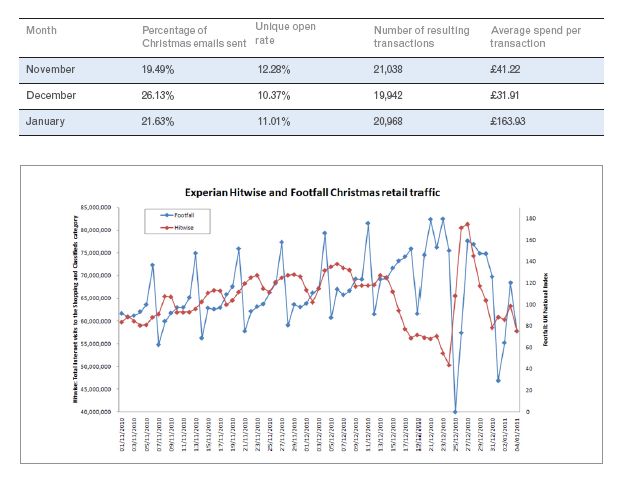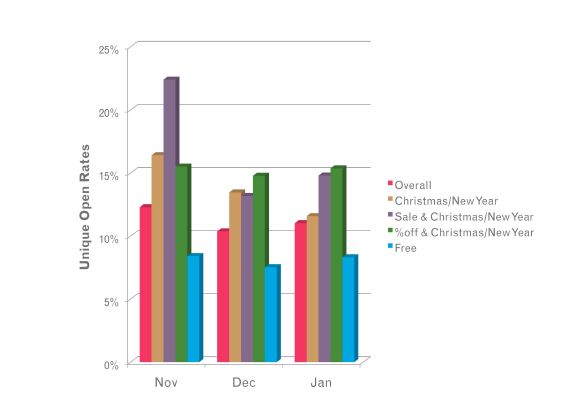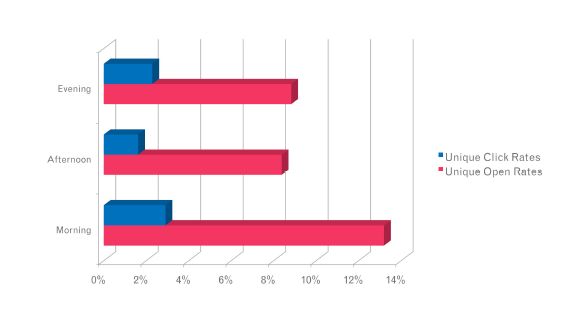We all know about the modern phenomenon of ‘Christmas-creep’. A few years ago, Christmas lasted a fortnight; but today -judging by when the decorations appear – it begins at some point in August. If you haven’t started your Christmas marketing campaigns yet, don’t worry, there is still time. But to ensure maximum returns on their marketing campaigns, marketers need act fast and use the data and intelligence available to create an informed strategy for the festive period.
The perfect time to start email marketing campaigns
Figures from Experian Hitwise show that festive emails begin to have a real effect during November, and the number of transactions resulting per campaign are higher than at any other time of the year Interestingly, December only accounts for a quarter of all Christmas related emails that are sent, but the resulting transaction rate is lower than in either November of January.
Somewhat surprisingly, internet traffic peaks just after Christmas and carries through into early January, with the first month of the year showing the highest average spend by far. This post-Christmas frenzy can be attributed in part to people going into shops, on and offline, to spend gift vouchers and enjoy the sales.

Essentially, the key time to start sending your seasonal campaigns is now. Statistics from 2010 suggest that the 2nd and 3rd week in November are best. Launching a properly targeted campaign now will hit customers as at the perfect time as they make their purchasing decisions ahead of the Christmas period, and keep them engaged during the January sales.
Targeting the right offering to the right customer
Christmas email marketing campaigns can be unsuccessful if not correctly executed. The scatter-gun approach can blow up in marketers’ faces, simply because, as a consumer, being inundated with offers for things we have no interest in is extremely annoying. This can lead to anti-marketing — when marketing campaigns discourage potential customers rather than intriguing and enticing them.
Marketers need to ensure that they deliver campaigns that base distribution on what customers are interested in. If a customer has been looking at extreme mountain biking products online, for example, it’s unlikely they’ll be interested in emails about antiques, but they may well be very keen on outdoor sports wear.
Using data and analytics can also drive cross and up-selling with existing customers; if they’ve just bought a mountain bike, you could offer deals on helmets and bike pumps (and perhaps, serious injury insurance) in the pre and immediate post-Christmas period.
Perfect presentation to drive responses
Brands need to ensure they cut through the noise at Christmas and deliver campaigns that really stand out, so creativity is important here. You should consider the possibility of including video in your mailouts or an animation to push up the open and response rates.
With email, this demands the integration of art and science, with pretty packaging made possible through some clever coding. Be sure to run a preliminary campaign in a test environment to ensure readability and accessibility of your mail through all desktop and mobile email operating systems.
You can also use the keywords that generate the best responses in subject lines. Christmas 2010 threw up some interesting opening rate results.
November: ‘Christmas’ was popular, but this was increased when combined with concepts such as ‘sale’ or ‘XX% off’ with a 22.39 per cent open rate.
December: What is surprising is that interest in ‘Christmas’ tailed off in December with a fall in open rates to just over 13 per cent, which could have been caused by adverse weather and seasonal fatigue . The most successful email campaigns in December were those with a subject line containing offers of competitions and prizes, , maybe because the holiday period gives us more free time to spend engaging with this type of content. A word of warning, however, as subject lines containing words such as ‘congratulations’ and ‘free’ fared less well, with opening rates of just 7.5 per cent and 2.4 per cent respectively in December— largely because people associate these terms with spam.
January: As we’d expect, ‘sales’ feature strongly here, as do ‘competitions’ and as the cost of Christmas begins to sink in, so too does ‘free delivery’.

When, where and how to use email and social media to generate responses
We can also improve the efficacy of email marketing by considering where and when customers open their email, whether that be on the move or in the comfort of their own homes.
2011 research from mobileSQUARED suggests that come 31st December there will be over 32 million smartphones in the UK, representing a penetration rate of more than 50 percent, and by 2015 they believe this will be 100 percent. This means that half of your customers could be opening their emails whilst they’re on the move in 2012, and if marketing emails aren’t optimised for mobile; your customers are not always getting the message.
The day of the week and time of day that emails are sent have a big effect too. Throughout the Christmas period, mornings generated the best unique open and click rates as customers looked for the best offers available. Evenings came in second and afternoons were the least productive time to send. While no single day emerged as a clear favourite in December and January (perhaps owing to disrupted routines), in November, we saw that Tuesdays, Wednesdays and Thursdays were the best days to send email.
 Christmas campaigns can be very beneficial for marketers, so to ensure that your email marketing push is successful, make sure you follow these key steps:
Christmas campaigns can be very beneficial for marketers, so to ensure that your email marketing push is successful, make sure you follow these key steps:
• Use data and analytics to get the right email to the customer every time
• Optimise emails so customers can read them where they want to read them
• Time your emails so that customer receive your content when they want to be emailed and are most likely to buy
• Get creative to ensure engagement and conversion into sales
• Integrate your campaigns with social media so that they can help you to spread the word





